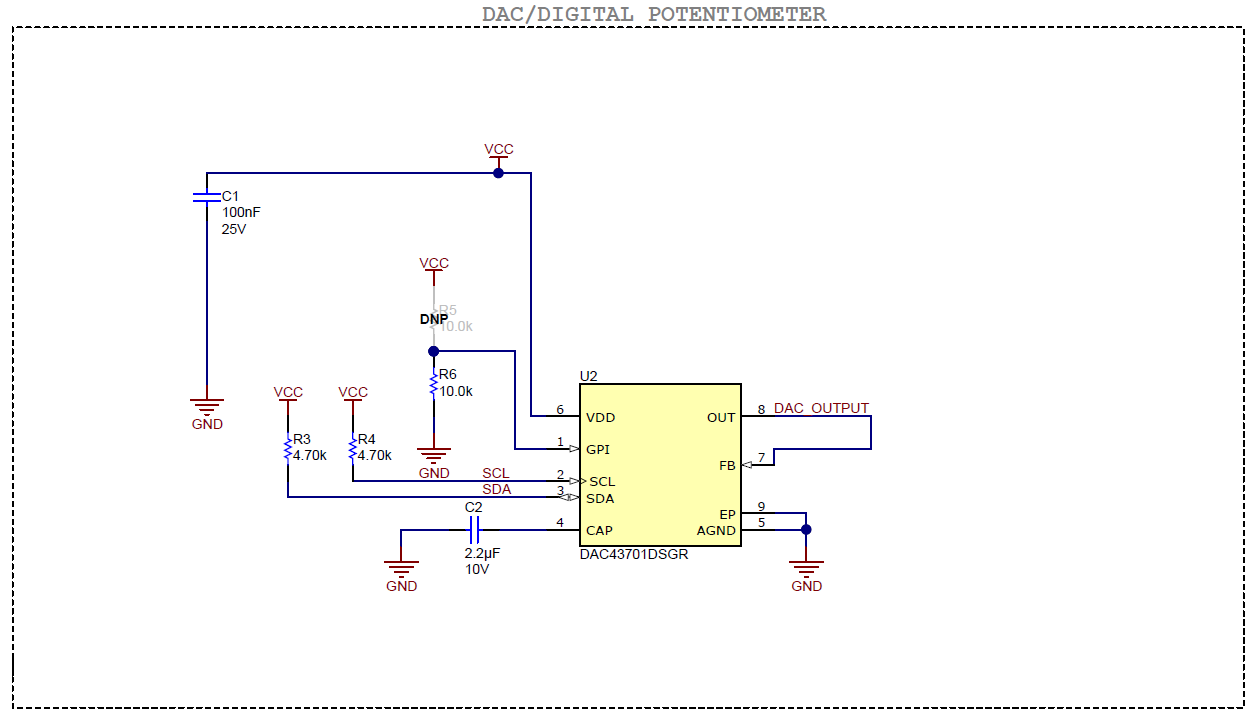SBAU376A December 2021 – March 2022
- 1
- Abstract
- Trademarks
- 1Overview
- 2Kit Contents
- 3Related Documentation From Texas Instruments
- 4Hardware
- 5EVM Operation
- 6Schematics, PCB Layout, and Bill of Materials
- 7Revision History
4.1.1 Adjusting Threshold With DAC
One option for setting the BOP of the TMAG5328 is to use the onboard DAC43701 DAC to output a voltage on the TMAG5328 ADJ pin. The DAC43701 is an 8-bit voltage-output DAC with nonvolatile memory and I2C interface. The nonvolatile memory retains the set values in the absence of a power supply. As a result, if the DAC output settings are stored in the nonvolatile memory of the DAC, a microcontroller does not need to reconfigure the DAC after each reset. The DAC43701 can set the BOP of the TMAG5328 without using the SCB afterward if the desired DAC output voltage was previously stored in the nonvolatile memory of the device. The SCB and GUI is only needed for the initial programming of the DAC voltage and the storing of this voltage into nonvolatile memory.
The DAC43701 also has an internal reference option feature that is used in the TMAG5328EVM. By using the internal reference, the output voltage of the DAC does not change drastically across power supply voltage as long as the power supply voltage for the DAC43701 is anywhere within the recommended 1.8V to 5.5V range.
Use Equation 1 to translate the voltage on the ADJ pin into the BOP setting:
where:
- BOP is in units of mT
- ADJ voltage is in units of mV
The TMAG5328 ADJ pin can accept a voltage from 0.16V to 1.2V. To stay within this voltage range, the GUI verifies that the DAC output voltage cannot be set outside of the 0.16V to 1.2V range.
The GUI allows setting the DAC voltage based on the following options:
- The magnetic flux density currently sensed by the TMAG5328: For this option, the DAC determines the sensed magnetic flux density by sweeping the voltage on the ADJ pin from 1.2V (15mT) to 0.16V (2 mT) and then finding the first DAC code that causes the output of the TMAG5328 to assert low. This first DAC code is converted back into the corresponding DAC output voltage and then the corresponding BOP using the equation above. If the TMAG5328 is asserted low after applying 1.2V to the ADJ pin, then the sensed magnetic flux density is greater than the maximum 15-mT BOP supported by the device. If the TMAG5328 is still asserted high even after applying 0.16V to the ADJ pin, the sensed magnetic flux density is less than the minimum 2-mT BOP supported by the device.
- Manually inputting one of the parameters below (the GUI only enables one of these parameters at a time):
- Desired BOP
- Desired voltage on the ADJ pin
- ADJ equivalent resistance: This setting simulates applying a resistor on the ADJ pin by applying a voltage that creates the same BOP as the input resistance.
The GUI also calculates an equivalent resistance value based on the DAC output voltage. The equivalent resistance value is the resistance value for the fixed-resistor threshold adjustment option that generates the same BOP as the currently set DAC output voltage. The equivalent resistance calculation allows the GUI to use the DAC to precisely determine the required ADJ resistance value that is needed in a final system that does not have a DAC.
Figure 4-2 shows a schematic snippet of the DAC43701 portion of the TMAG5328EVM. The schematic snippet below is also compatible with the DAC43701, which is the 10-bit version of the DAC43701. In addition, the snippet is also compatible with the TPL1401, which is an 8-bit digital potentiometer device.
To select the DAC option for setting BOP, the DAC output must be connected to the ADJ pin, which is done by the following steps:
- Do not populate resistor R7.
- Connect a jumper between the "DAC" (pin 1) and "ADJ" (pin 2) pins of header J3.
 Figure 4-2 Schematic Snippet of DAC43701 Portion of TMAG5328EVM
Figure 4-2 Schematic Snippet of DAC43701 Portion of TMAG5328EVM